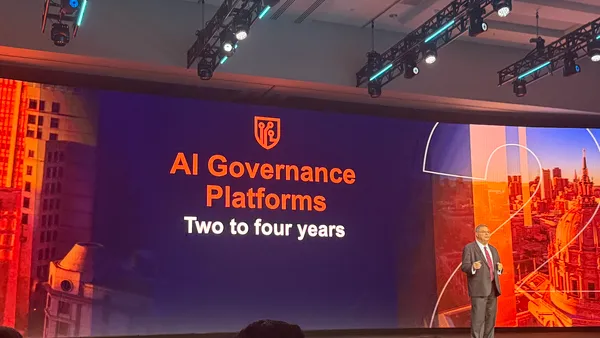With a recession marker or two flashing red for the year ahead, tech managers are setting 2020 budget priorities with an eye toward maximizing resource efficiency, with data analytics and automation leading the way.
At data analytics firm Talend, a 2020 budget priority will be investing to increase the analytical capabilities of its sales and marketing outfits, CEO Mike Tuchen told CIO Dive.
The playbook guiding Talend's budget closely aligns with a trend highlighted by this year's Harvey Nash/KPMG survey, which found robotic process automation (RPA) and data analytics grew the size of global tech budgets.
Driven by increased adoption across industries, investment in "new tech" categories is on the rise. By next year, the market is expected to hit the $1 trillion mark, according to IDC's global spending forecast for 2018-2022.
To ensure initiatives earn the go-ahead from top leadership, tech managers must prove efficiency outcomes, and provide business cases grounded in data as they push for 2020 investments.
Selling the impact
One way leadership can be swayed to green-light tech proposals is for CIOs to prove they'll impact revenue, said Nick Hahn, a director in digital practice at West Monroe Partners.
But, at times, the more convincing argument is the risk of inaction.
"We create what's called a 'Value at Risk' analysis," said Hahn, whose consulting firm advises CIOs. "We say, 'if you were to do nothing, here's the negative impact of that.'"
One company in the financial industry, a client of Hahn's firm, was convinced to deploy tech after stats showed it risked customer attrition by delaying updates to its online banking systems.
Another strategy follows what Hahn calls the "thin edge of the wedge" approach: Budgeting a small project that can deliver efficiency gains quickly, then open up the possibility for expansion in the future.
"You can quickly realize efficiency gains, as opposed to customer growth gains," Hahn said.
This approach resonates with Talend's guide to budgeting. The Redwood City, Calif. firm, with a team of 1,300 staffers, takes its cues from Agile methodologies when approaching any project, Tuchen said.
"The most important thing is to have a clear goal of what you're trying to accomplish," Tuchen said. "Chose how you'll measure success and take an incremental approach."
In Talend's case, clear success metrics help break down projects into individual components.
Planning for efficiency
Ultimately, companies pushing for technology deployments in 2020 budgets look for a return on investment, though that return can show itself in many ways.
For companies deploying RPA, that can mean freeing up time from employees. Banks using AI-generated ad copy see increased conversion rates. Factories using AI to monitor network efficiency are able to sidestep production downtime.
With looming signs of an economic slowdown, the imperative of productivity can sell decision-makers on putting resources behind tech.
But one objective is often overlooked, Hahn said. Using tech to open up new revenue streams or maintain an existing customers base.
"It may open up a dialogue about alternative revenue streams," Hahn said. "Are there services that would provide value for your customers?"












